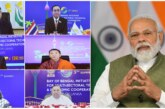“Te environment is the thread that unites all our actions. Together we can overcome the siege of our planet. We can build a future where people & nature thrive”.
– Executive Director of UNEP, Inger Anderson.
It’s been more than two years post the notification of Wetlands (Conservation and Management) Rules, 2017, guidelines to support state governments to implement wetland rules have been published. With the theme “Strengthening Actions for Nature to Achieve the SDGs” for the year 2020 at United Nations Environment Assembly (UNEA 5), these guidelines become significant for a country like India which is endowed by a rich diversity of wetlands, ranging from high altitude wetlands of Himalayas, floodplains of rivers like Ganga and Brahmaputra, lagoons and mangrove marshes on the coastline and reefs in the marine environments.
 World Wetlands Day on 2nd February 2020, with theme ‘Wetlands & Biodiversity’ has heightened significance of wetlands and its association with biodiversity, natural resources like air, water, ground water & surface water recharge, flora-fauna-avian habitat & livelihood security. We have 30% land-based carbon stored in peatland; one billion people depend on wetlands for their livelihoods & wetlands provide $47 trillion in essential services annually. Given that India has approx 7.57 lakh wetlands covering nearly 4.7% of India’s geographical area, Wetlands are repository of ‘natural environmental capital’ to enhance socio-economic development and not just concrete economic growth.
World Wetlands Day on 2nd February 2020, with theme ‘Wetlands & Biodiversity’ has heightened significance of wetlands and its association with biodiversity, natural resources like air, water, ground water & surface water recharge, flora-fauna-avian habitat & livelihood security. We have 30% land-based carbon stored in peatland; one billion people depend on wetlands for their livelihoods & wetlands provide $47 trillion in essential services annually. Given that India has approx 7.57 lakh wetlands covering nearly 4.7% of India’s geographical area, Wetlands are repository of ‘natural environmental capital’ to enhance socio-economic development and not just concrete economic growth.
In a major recognition towards conservation and rejuvenation of its wetlands, 10 more wetlands in India have been recognised as Ramsar sites taking to a total of 37 Ramsar wetlands. Ministry of Environment, Forest and Climate Change has prepared a four pronged strategy for the restoration of wetlands which includes preparing a baseline data, wetland health cards, wetland mitras and Integrated Management Plans.
Rules as Milestones
The guidelines to the implementation of wetlands is specific on ‘wise-use’ of wetlands, through an “emphasis on sustainable development”, calling for resource use patterns which can ensure that human dependence on wetlands can be maintained not only in the present but also in the future, working closely with the State Wetland Authorities. The guidelines recommended that the management of each notified wetland is guided by an “integrated management plan” which details strategies and actions. In view of the growing recognition of indispensability of wetlands to address climate change, investing in wetlands shall enhance climate resilience, improve livelihood security of people and fostering economic growth in tandem with water-energy-food security.
Guidelines state that authorities must ensure that the wetlands are either registered appropriately or take steps in registering the wetland in land revenue records for protecting encroachment or illegal claims. Our visit to Fatehpur District Magistrate, Aspirational District of Uttar Pradesh (2019) gave us insights that district administration is actively rejuvenating lost water bodies and maintaining revenue records in an ordered way.
With Jal Shakti Abhiyan focus on water conservation through Jan Andolan and Jal Jeevan Mission provides for 24×7 piped water supply, wetlands is a part of equation of water & accommodate contemporary interventions. This was iterated during a panel discussion on ‘Integrated National Water Policy’ organized by SKOCH and India Water Foundation as a part of BOOND Dialogue. Such an integrated approach towards wetlands, providing livelihoods to almost 40% of total population shall also aid water conservation & enhance promotion of Ecosystem Services (ESS).
Understanding Wetland guidelines for SMEs
Millennium Ecosystem Assessment (2005) study estimated that wetlands cover 7% of the earth’s surface and deliver 45% of its natural productivity and ecosystem services. These natural resources are estimated at $20 trillion a year. As we all know, India has a strong ecosystem for MSMEs and is poised to become third-largest world economy and one of the top three manufacturing destinations by 2030, role of MSMEs is significant.
It is noteworthy to mention that a total of 6.4 crore MSMEs contributes nearly 28% of the overall GDP of $2.75 trillion making them worth nearly $870 billion per annum. Given our Prime Minister’s dream of achieving 5 trillion economy, Climate-sensitive strategies in MSMEs focusing on waste-to-resource conversion, Clean & Efficient energy, transformation of Grey-to-Green Infrastructure, essentially revolving around circular economy principles of ‘sustainable production & consumption’. The rules prohibit discharge of untreated waste and effluents from industries, cities, towns, villages, and other human settlements. Sectors of Aquaculture, Sericulture, horticulture, etc will go a long way to support surface & ground water quality, wetland conservation & livelihood security as well.
Age of Wetlands vs Age of Wastelands
Every wetland is ecologically unique. It recycles nutrients, purifies and provides drinking water, reduces flooding, recharges groundwater, provides fodder and fuel, facilitates aqua-culture, provides a habitat for wildlife, buffers the shoreline against erosion and offers avenues for recreation. But now, embankments are turning marshes into encroached zones affecting ‘availability, quantity & quality of wetlands’. Further, threatened by reclamation by draining and filling, besides pollution, and are exploited for their natural resources, leading to the loss of biodiversity & large-scale destruction.
The guidelines recommended that “state/union territory wetlands authority, based on consideration of site-specific conditions, may consider expanding the list of prohibited activities. Each activity, however, would need to be considered on a case to case basis keeping in mind the ecological character of wetlands. The IPBES 2019 (Intergovernmental Science-Policy Platform on Biodiversity and Ecosystem Services) the global assessment identified wetlands as the most threatened ecosystem. Among 22 Indian cities, Mumbai has lost the maximum number of wetlands – 71% – between 1970 and 2014, according to a national study by a non-profit group, Wetlands International South Asia (WISA). Chennai lost a third of wetlands in a decade, Kerala’s water sources facing degradation due to illegal encroachments. We also witness continued inflow of untreated sewage, dumping of waste on lakebeds, eutrophication leading to ground & surface water contamination and poor maintenance of/around wetlands. The systemic faults lines are increasingly becoming bigger. Call to conserve lifesaving water bodies is still on a slower pace. Excess extraction of groundwater is to blame for the 61% decline in groundwater level in wells in India between 2007 and 2017 (source: Central Ground Water Board (CGWB)).
India launched a five-year plan to conserve its wetlands as part of the National Action Plan for Conservation of Migratory Birds and their Habitats (2018-2023), a multi-state action plan for safeguarding and boosting the population of migratory birds in the country. National Green Tribunal directed an oversight committee to monitor and restore wetlands in Delhi’s Dwarka neighbourhood. Micro-level efforts through bottom-up approach will go a long way to save the wetlands of our country. If followed through diligently, this plan should help restore India’s wetland biodiversity hotspots.
As climate targets of countries and goals are spearheading efforts to limit global warming by 1.5 degree Celsius and 2°C goals committed under the Paris Agreement Discussions, linkages between SDGs and Wetlands on the one hand and linkages between the Wetlands and the Paris Agreement on Climate Change (PACC) to which India is already a signatory to, must be incorporated. The judicious conservation and management of wetlands also require Ecosystem-based Adaptation (EbA), Integrated Water Resources Management (IWRM) services. To preserve the ‘Intrinsic value of wetlands’, propagating ‘Thinking Beyond’ conventional methods and employing Nature Based and Science Based Solutions can sustainably manage and restore wetland ecosystems.
Pushing a pedal on Wetlands
Wetlands strengthen ecosystem services. Hence, innovative scientific technologies and information sharing be employed towards wetland conservation; augmentation along with biodiversity is needed to conserve this critical ecosystem. Super Year 2020 for nature must align with wetlands preservation, conservation & management. While focusing on commitment and sustainability, this approach also emphasizes on bringing rural-urban disequilibrium on an even keen in the realm of natural resources, especially in water sector. While ensuring conservation of biodiversity, this approach also takes care of ecosystem services and the benefits accruing from them in a sustainable manner. 2020 is a critical year for nations’ commitments to preserving and restoring biodiversity, with Italy hosting the 15th meeting of the Conference of the Parties (COP15) to the UN Convention on Biological Diversity (UN-CBD). The 13th meeting of the Conference of the Parties to the Convention on the Conservation of Migratory Species of Wild Animals (CMS COP13) being held in Gandhinagar, India next week with theme: “Migratory species connect the planet and together we welcome them home.” The above commitments & outcomes shall be showcased for countries & stakeholders to emulate.
Here, Wetlands should Commit rather than Threatening water-related ecosystems.
—————————————————————————
Dr Arvind Kumar is President, India Water Foundation.
Article published in SME World Magazine | February 2020



